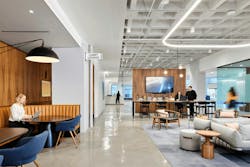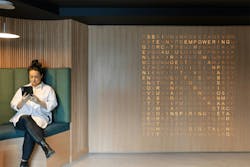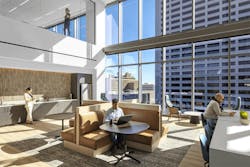HOK presents neurodiversity research and design guidelines at SXSW 2024
Kay Sargent, Director of Thought Leadership, Interiors, and Tom Polucci, firm-wide Director of Interiors, presented their research on the relationship between the built environment and sensory processing at the South by Southwest Festival in Austin, Texas. Their presentation, “The Future of the Workplace is Neuroflexible,” highlighted opportunities for creating more inclusive workspaces that accommodate neurodiverse individuals.
Inclusive policies and spaces are critical to the performance, sense of belonging and overall satisfaction of the more than 20% of the workforce considered to be neurodivergent. These design interventions can improve the experience for all employees, ultimately creating a more human and empathetic workplace.
In their session, Polucci and Sargent shared their latest findings, exploring how design elements such as colors, textures, lighting and sound might differently activate individuals with hyper- or hypo-sensitivities, or those who prefer less or more stimuli. They highlighted common pain points, often overlooked sensory inputs and key approaches to addressing neurodiversity in the office.
Sargent pointed out the intentionality of using “Neuroflexibility” instead of “Neurodiversity” in their SXSW presentation title. “What we found over the last eight years is that every single person in this room is constantly assaulted by sensory stimulation. You don’t have to be at the ends of the spectrum to be annoyed by sound, temperature or light,” she said. “But what might be annoying for someone who is neurotypical might be debilitating to someone with ADHD, Tourettes or another condition.”
When HOK began researching neuroinclusive environments, one in eight people were considered neurodivergent. Today, that ratio is one in five—yet many are never diagnosed. “We are starting to realize how massive of a percentage of the population is impacted by this,” said Sargent. “But you’d be in really good company, because they tend to be entrepreneurs, outside-the-box thinkers and super creative. Many of them have a hyperfocus.”
As children, we were taught that humans have five senses. Polucci pointed out, however, that there are actually eight senses that we all experience. In addition to the well-known five (sight, hearing, touch, taste and smell), he said three more senses play a crucial role in how we interact with our environment.
The first additional sense is interoception, which Polucci referred to as how we feel on the inside and how our body reacts to various stimuli. For instance, based on our internal sensations, we may feel a sense of comfort or discomfort.
The second sense is the awareness of our surroundings and how we perceive the space around us. This includes the sensation of objects or people being too close or feeling confined in a tight space.
Lastly, Polucci explained how our sense of position and balance, known as proprioception, is essential for navigating and interacting with our environment. This sense allows us to understand where our body is in relation to the space around us.
Sargent emphasized that designing for the extreme sensory needs of neurodivergent individuals ultimately benefits everyone. “This is not just about doing something for the 20% that might be neurodivergent,” she said. “This is about making spaces more functional for 100% of the people that are in your spaces by truly understanding how the elements in that environment are impacting us, and how we can design to do things better.”
Listen to an audio recording of Polucci and Sargent’s “The Future of the Workplace is Neuroflexible” SXSW 2024 presentation.
ONEder Grant: A Case Study
HOK was recently awarded a ONEder grant to further test our design principles and develop comprehensive guidelines for a more neuroinclusive workplace. This pioneering research, an evolution of nearly a decade studying how the built environment impacts workers across the cognitive spectrum, serves as a model for best practices and practical strategies to accommodate a diverse range of sensory processing needs and cognitive styles.
The ONEder grant has enabled HOK’s team to evaluate and refine design guidelines from previous research and work. Using real-world pilot spaces, our investigation engaged both neurodiverse and neurotypical employees in focus groups, surveys and pre- and post-occupancy evaluations to validate and analyze how the built environment impacts the cognitive and sensory experience. The findings from the ONEder grant provide practical examples in managing, renovating and building new facilities with a special focus on supporting a broad spectrum of sensory processing challenges and various neuro-distinctions, serving as a resource for clients and the design community.
HOK’s guidelines offer an actionable and scalable approach to assessing the opportunities for accommodations and determining steps to improve inclusion. Key considerations include providing choice, access to daylight, a mix of quiet and more active spaces, adjustable lighting, ergonomic furnishings and biophilic references. The guidelines also emphasize strategic planning to reduce visual and auditory distractions and zoning to prioritize important connection points and lines of sight. Findings from the ONEder grant research test recommendations for practically implementing these considerations by evaluating operational interventions, access points, planning, circulation, furniture, wayfinding and other design elements such as materiality, color and acoustics.
As neurodiversity takes center stage in the conversation around diversity and inclusivity, HOK’s iterative process provides clients a research-based framework for implementing user feedback and performance data to improve the overall spatial experience. From steps for inclusion and six modalities of work to spatial sequencing and the most effective operational strategies and design adjustments, this latest research is our next step in investigating practical applications that optimize the workplace.
In this video, Sargent explains the impact of workplace design on employee performance and engagement, describing how thoughtful design can better support individuals across the cognitive spectrum.
Note: Neurodiversity is a term used to describe a broad range of conditions, some of which likely will be unresponsive to design solutions. HOK’s approach to inclusive design is based on our experience as designers and architects with the objective of providing a wide range of options for users with different needs. Any attempt to address the needs of neurodiverse individuals should also include review of human resources policies, implementation of technology solutions and building operations among other considerations. HOK does not represent that any design solution discussed in this publication is capable of achieving any specific outcome for an individual user.



